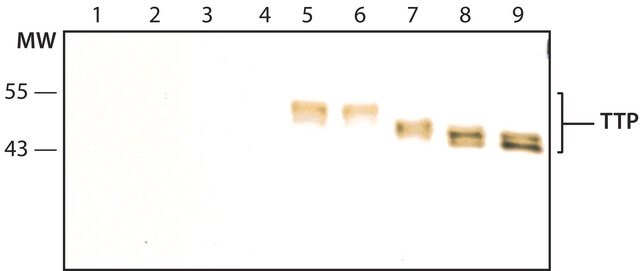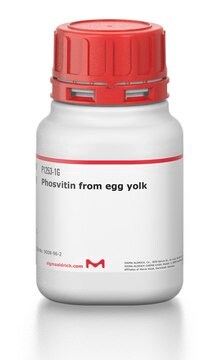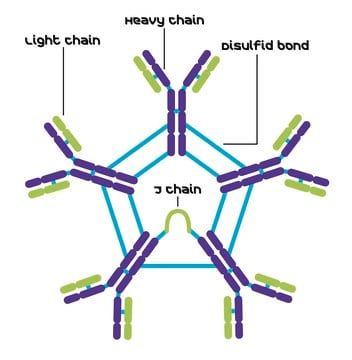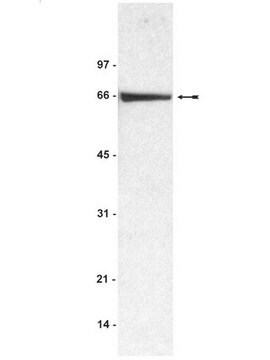T5452
Anti-TTP (C-terminal) antibody produced in rabbit
~1.0 mg/mL, affinity isolated antibody, buffered aqueous solution
别名:
Anti-G0/G1 switch regulatory protein 24, Anti-GOS24, Anti-Growth factor-inducible nuclear protein NUP475, Anti-NUP475, Anti-RNF162A, Anti-TIS11, Anti-Tristetraprolin, Anti-Zfp36, Zinc finger protein 36 homolog Protein
登录查看公司和协议定价
所有图片(1)
About This Item
分類程式碼代碼:
12352203
NACRES:
NA.41
推荐产品
生物源
rabbit
品質等級
共軛
unconjugated
抗體表格
affinity isolated antibody
抗體產品種類
primary antibodies
無性繁殖
polyclonal
形狀
buffered aqueous solution
分子量
antigen ~50 kDa
物種活性
human
濃度
~1.0 mg/mL
技術
western blot: 0.5-1.0 μg/mL using lysates of HEK-293 cells overexpressing human TTP
UniProt登錄號
運輸包裝
dry ice
儲存溫度
−20°C
目標翻譯後修改
unmodified
基因資訊
human ... ZFP36(7538)
mouse ... Zfp36(22695)
rat ... Zfp36(79426)
一般說明
TTP is also known as Tristetraproline, Zfp-36, TIS11A, and Growth factor-inducible nuclear protein NUP475. TTP belongs to a family of human ARE (AU-rich element found in 3′ UTR mRNA) binding protein that contains tandem CCCH zinc finger RNA-binding domains required for interaction with ARE. TTP is a phosphoprotein. Anti-TTP (C-terminal) is produced in rabbit using as immunogen a synthetic peptide corresponding to human TTP conjugated to KLH.
免疫原
synthetic peptide corresponding to amino acids 270-284 of human TTP conjugated to KLH. The corresponding sequence differs by one amino acid in mouse and rat.
應用
Anti-TTP (C-terminal) antibody has been used in immunoprecipitationand may be used for immunoblotting.
生化/生理作用
Tristetraprolin (TTP) is an RNA-binding protein that suppresses inflammation by accelerating the degradation of cytokine mRNA. TTP plays a role in both mRNA deadenylation and 3′ to 5′ degradation of the mRNA and helps in recruiting several factors involved in these processes. TTP acts as a substrate for multiple kinases like ERK (extracellular signal-regulated kinases), JNK (Jun N-terminal kinase) , p38, and MAPKAPK2.
標靶描述
TTP (C-terminal) (also known as Tristetraproline, Zfp-36, TIS11A, and Growth factor-inducible nuclear protein NUP475) is an RNA-binding protein that suppresses inflammation by accelerating the degradation of cytokine mRNA.
外觀
Solution in 0.01 M phosphate buffered saline, pH 7.4, containing 15 mM sodium azide.
免責聲明
Unless otherwise stated in our catalog or other company documentation accompanying the product(s), our products are intended for research use only and are not to be used for any other purpose, which includes but is not limited to, unauthorized commercial uses, in vitro diagnostic uses, ex vivo or in vivo therapeutic uses or any type of consumption or application to humans or animals.
未找到合适的产品?
试试我们的产品选型工具.
儲存類別代碼
10 - Combustible liquids
閃點(°F)
Not applicable
閃點(°C)
Not applicable
個人防護裝備
Eyeshields, Gloves, multi-purpose combination respirator cartridge (US)
Posttranslational regulation of tristetraprolin subcellular localization and protein stability by p38 mitogen-activated protein kinase and extracellular signal-regulated kinase pathways
Brook M, et al.
Molecular and Cellular Biology, 26(6), 2408-2418 (2006)
Tristetraprolin mediates radiation-induced TNF-α production in lung macrophages
Ray D, et al.
PLoS ONE, 8(2), e57290-e57290 (2013)
Dipankar Ray et al.
PloS one, 8(2), e57290-e57290 (2013-03-08)
The efficacy of radiation therapy for lung cancer is limited by radiation-induced lung toxicity (RILT). Although tumor necrosis factor-alpha (TNF-α) signaling plays a critical role in RILT, the molecular regulators of radiation-induced TNF-α production remain unknown. We investigated the role
Interactions of CCCH zinc finger proteins with mRNA non-binding tristetraprolin mutants exert an inhibitory effect on degradation of AU-rich element-containing mRNAs
Lai W S, et al.
The Journal of biological chemistry, 277(11), 9606-9613 (2002)
Roles of Tristetraprolin in tumorigenesis
Park J M, et al.
International Journal of Molecular Sciences, 19(11), 3384-3384 (2018)
我们的科学家团队拥有各种研究领域经验,包括生命科学、材料科学、化学合成、色谱、分析及许多其他领域.
联系技术服务部门








